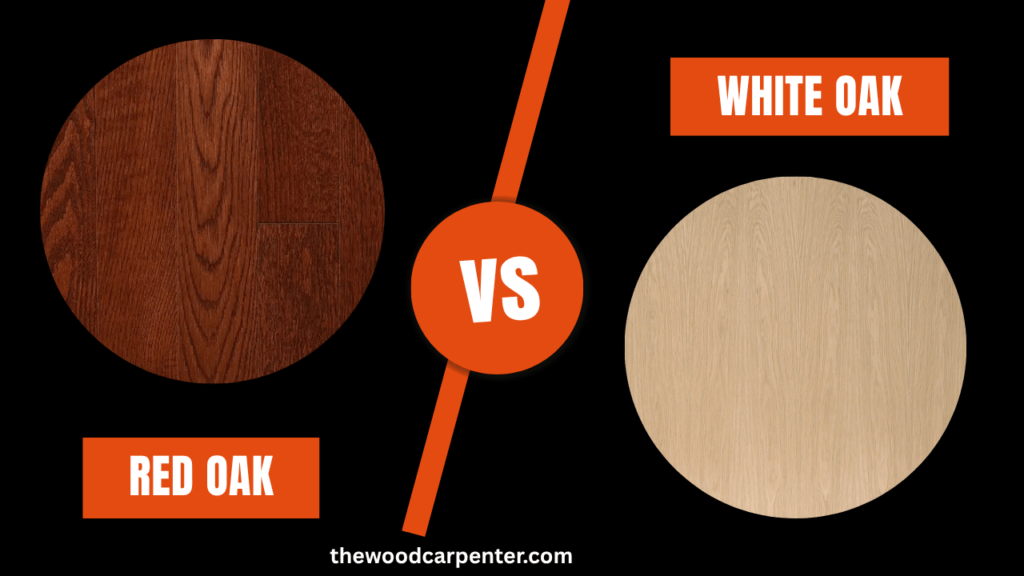
Red oak and white oak are two of the most common hardwoods for making furniture, floors, cabinets, and millwork in North America. These woods have the same name, “oak,” and similar grain patterns, but they look, last longer, cost more, and are better for different uses.
It’s important to know these distinctions so you can make the appropriate choice for your next project.
Appearance: Color and Grain
Color
Red Oak: Typically features a reddish or pinkish hue, but the color can range from light brown to deep red-brown. The name can be misleading, as not all red oak is distinctly red.
White Oak: Generally ranges from light to medium brown, sometimes with olive or yellowish tones. It tends to look more uniform and less “warm” than red oak.
Grain Pattern
Red Oak: Exhibits a more pronounced, open, and wavy grain pattern. The grain is often described as “cathedral” or “rustic,” with larger pores and more dramatic patterns.
White Oak: Has a tighter, straighter, and smoother grain. The rays (medullary rays) are longer and more prominent, especially visible on quartersawn boards, creating a subtle “flame” or “tiger” pattern.
Summary Table: Appearance
| Feature | Red Oak | White Oak |
| Color | Reddish/pinkish, warm tones | Light-medium brown, olive/yellow |
| Grain | Open, wavy, dramatic, rustic | Tight, straight, subtle, uniform |
| Rays | Short (≤ 1/2 inch) | Long (≥ 3/4 inch) |
Durability and Hardness
Janka Hardness
Red Oak: 1,220–1,290 lbf.
White Oak: 1,350–1,360 lbf, making it slightly harder and more resistant to dents and wear.
Water and Rot Resistance
Red Oak: The open pores make it more porous and less able to hold moisture. Not a good idea to use outside or in places with a lot of humidity. Water might get in and leave black stains or make things bend.
White Oak: The tyloses in the pores make it very resistant to water and decay. White oak is used to make boats, barrels, and outdoor furniture for this reason.
Stability
Red Oak: More prone to shrinking and swelling due to moisture changes.
White Oak: More stable and less likely to warp or twist over time.
Workability and Finishing
Red Oak
- Easier to sand and machine due to its slightly softer nature.
- Takes stain and finish very well, producing even color without blotching.
- The open grain can make it more challenging to achieve a perfectly smooth finish.
White Oak
- Slightly harder to work with but still machines and finishes well.
- The closed grain can make staining less even, but it takes finishes beautifully and can be polished to a high sheen.
- Quartersawn white oak is especially prized for its unique ray fleck patterns.
Also read:
Is Guanacaste Wood Worth the Hype ?
Cost and Availability
Red Oak: More abundant, grows faster, and is widely available across North America. This makes it more affordable and easier to source, especially for large projects.
White Oak: Less common, grows slower, and is more expensive. Its superior durability and water resistance often justify the higher price for certain applications.
Common Uses
| Application | Red Oak | White Oak |
| Flooring | Yes, especially for interiors | Yes, especially for high-traffic areas |
| Furniture | Yes | Yes |
| Cabinets | Yes | Yes |
| Outdoor Projects | Not recommended | Excellent (boats, decks, barrels) |
| Stairs & Trim | Yes | Yes |
| Decorative Veneers | Yes | Yes, especially quartersawn |
Pros and Cons
Red Oak Pros
- Easier to stain evenly.
- More affordable and widely available.
- Dramatic grain hides scratches and dents well.
- Easier to work with hand and power tools.
Red Oak Cons
- Less durable and more prone to dents and scratches than white oak.
- Poor water and rot resistance; not suitable for exterior use or wet areas.
- Can shrink and swell more with humidity changes.
White Oak Pros
- Superior hardness and durability.
- Highly resistant to water, rot, and insects due to closed pores and tyloses.
- More stable and less likely to warp.
- Unique ray fleck patterns in quartersawn boards.
White Oak Cons
- More expensive and harder to source.
- Can be harder to stain evenly due to closed grain.
- Slightly harder to machine and work with.
How to Tell Red Oak from White Oak
End Grain: Red oak has open pores, but white oak’s pores are closed with tyloses, which means you can’t blow air through white oak.
Rays: The rays of red oak are small, while those of white oak are long and stand out.
Color: Red oak is reddish, while white oak is more brown or olive. However, color alone isn’t always a good indicator.
Grain: White wood is straighter and tighter, whereas red oak is more open and wavy.
The shape of the leaves on trees: Red oak leaves have sharp lobes, whereas white oak leaves have rounder lobes.
Frequently Asked Questions (FAQ)
1. Which is better for flooring, red oak or white oak?
White oak is generally preferred for flooring in high-traffic or wet areas due to its superior hardness and water resistance. Red oak is still an excellent choice for most interior floors and is more affordable.
2. Can I use red oak outdoors?
Red oak is not recommended for outdoor use because it is not rot or moisture resistant. White oak is much better suited for exterior projects.
3. Why is white oak more expensive?
White oak is less abundant, grows slower, and is more difficult to harvest and process, which increases its price. Its superior durability and versatility also add to its value.
4. Does red oak or white oak stain better?
Red oak’s open grain structure allows it to absorb stain more evenly, making it easier to achieve a uniform finish. White oak can be harder to stain evenly due to its closed grain, but it still finishes beautifully with proper preparation.
5. How do I match existing oak woodwork?
Look closely at the grain and color. If possible, examine the end grain for open (red) or closed (white) pores. For an exact match, bring a sample to a lumberyard or woodworker for expert identification.
6. Is there a difference in maintenance?
Both types require regular cleaning and occasional refinishing. White oak’s water resistance makes it lower maintenance in wet or outdoor settings.
Final Thoughts
Choose Red Oak if you want a more affordable option with a bold grain and easy workability for indoor projects.
Choose White Oak if you need higher durability, better water resistance, and a smoother, more elegant finish—especially for outdoor or high-traffic areas.
Both types of oak are excellent choices, but the right one depends on your project needs, style preferences, and budget.

